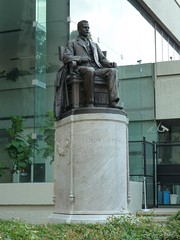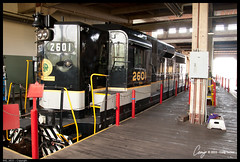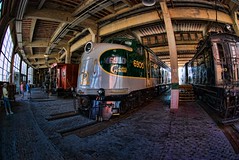Spencer
"The Naming of a North Carolina Railroad Town"
by Walter R. Turner
Reprinted with permission from the Tar Heel Junior Historian. Spring 2005.
Tar Heel Junior Historian Association, NC Museum of History
Related Entries: Transportation Air and Rail; Transportation: History; Railroad Carry Wounded Soldiers; Company Shops
The town of Spencer, located near Salisbury in Rowan County, was named for one of the nation’s railroad leaders, Samuel Spencer. A native of Georgia, Samuel became the first president of Southern Railway.
Company Shops (which later became Burlington) served as the headquarters of the North Carolina Railroad during the last half of the nineteenth century. The town’s name refers to the series of buildings built to serve the railroad. Wilmington, the headquarters of the Atlantic Coast Line Railroad for the first half of the twentieth century, was named for an English nobleman. The city had developed as a major port before the railroad arrived.
To understand Samuel Spencer’s remarkable life and influence on North Carolina and the South, consider three key decisions he made as a teenager and young man.
Samuel Spencer was born in 1847, the only child of a wealthy cotton planter-merchant and his wife, near Columbus, Georgia. As a boy, he learned to ride horses and observed his father’s skills in running a cotton business. At the beginning of the Civil War, he entered Georgia Military Institute outside Atlanta.
Samuel’s first key decision was to join the Confederate army in 1864 at the age of seventeen. Since he had his own horse, he could join a cavalry unit, which was more prestigious than being in the infantry. Serving under the famous general Nathan Bedford Forrest, Samuel’s learned the importance of leadership. Participating in battles allowed him to travel to areas of the South beyond Georgia.
Completing his education after the war was Samuel’s second key decision. Even though he entered and graduated from the University of Georgia, Samuel realized that he needed more education to reach his goals. He convinced his father that he was determined to become an engineer instead of returning to work in the family cotton business. His father accepted that decision and financed Samuel’s engineering degree at the University of Virginia, where he finished at the top of his class.
Samuel’s third key decision was choosing a career in railroading. Although railroading was still a young industry, he saw its potential to uplift the South and nation after the devastation of the war. His first railroad job was helping build a rail line for the Savannah and Western Railroad as a rodman, assisting the men surveying the line’s route. He was quickly promoted to a supervisory position.
Two years later in 1872, he began working in Baltimore for the Baltimore and Ohio Railroad (B&O), one of the nation’s leading railroads. The same year, he married Louise Benning of Columbus but had to postpone the honeymoon because of his work. Only a few years after the Civil War ended, Samuel was proving he could succeed in the northern states.
After several promotions, Samuel Spencer became president of the B&O in 1887. With his growing skills in finance, he then worked as a railroad advisor to J. P. Morgan, a wealthy New York banker. In 1894 Morgan agreed to finance the creation of Southern Railway if Spencer would serve as its president.
Burke Davis, the author of The Southern Railway, Road of the Innovators, wrote that Spencer was fortunate to enter railroading “during the period of expansion after the Civil War, when professional railroad men had begun to replace entrepreneurs as managers of large lines.”
Under Spencer’s leadership, the Southern Railway began buying small lines to form a strong business that would serve the entire South. The railroad chose Washington, D.C., as its headquarters. The company needed a facility halfway on its main line between Washington and Atlanta to maintain and repair steam locomotives and rail cars. This new facility was rapidly built outside Salisbury, North Carolina, on open land and in wooded areas. Someone in the company suggested that the complex be named Spencer Shops, in honor of Samuel Spencer.
When a town for the white railroad workers and their families developed across the street and was incorporated in 1905, it seemed only natural that it would be named Spencer. Many black workers and their families lived across the main line in an area that became the town of East Spencer.
Spencer Shops grew as the railroad expanded. The enormous Back Shop, two football fields long and three stories tall, opened in 1905. A new roundhouse of thirty-seven stalls opened in the mid-1920s. By the 1930s and during World War II, Spencer Shops employed up to three thousand people working around the clock.
In the 1940s and 1950s, however, Southern began using diesels instead of steam locomotives to lead its trains. Diesels could pull longer trains and required less maintenance than steam locomotives. The massive steam repair facility at Spencer Shops was obsolete and no longer needed, so the shops practically closed by 1960. At this same time, Interstate 85 opened, and traffic on the highway running through Spencer slowed to a trickle.
Fortunately, Southern gave the land and buildings of Spencer Shops to the State of North Carolina to form the North Carolina Transportation Museum. Trains still run at Spencer, thanks to the museum, which also features antique cars and many other forms of transportation.
Throughout the years of Spencer Shops and the museum, Samuel Spencer has not been forgotten. He died in a tragic railway wreck in 1906. The railroad’s employees contributed to a fund to erect a monument and statue at Atlanta’s rail station.
In dedicating the monument, Alexander Humphrey said of Spencer’s life, “Every opportunity found him ready, and every task of increased importance found him equal to it.”
At the time of this article’s publication, Walter R. Turner was historian at the North Carolina Transportation Museum at Spencer. He is the author of Paving Tobacco Road: A Century of Progress by the North Carolina Department of Transportation.
Additional Resources:
NC Transportation Museum: http://nctrans.org/
Spencer, North Carolina: http://ci.spencer.nc.us/
Samuel Spencer Monument: http://railga.com/oddend/spencer.html
Image Credits:
Carolina Doug, September 5, 2009. " Southern E-8 at the NC Transportation Museum in HDR thru the Fisheye." Located at https://www.flickr.com/photos/carolinadoug/3897388223/. Accessed February 23, 2012.
July 3, 2010. "Samuel Spencer Statue". Located at https://www.flickr.com/photos/37872410@N00/4889136276/. Accessed February 23, 2012.
Tucker, Craig. June 18, 2011. "IMG_9833". Located at https://www.flickr.com/photos/tuck/5849186748/. Accessed February 23, 2012.
1 January 2005 | Turner, Walter R.


